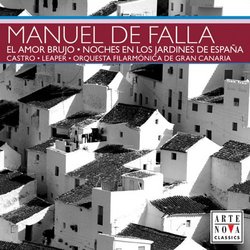| All Artists: Manuel de Falla, Adrian Leaper, Gran Canaria Philharmonic Orchestra, Ricardo Castro Title: Manuel De Falla: El Amor Brujo; Noches en los Jardines de Espaņa Members Wishing: 0 Total Copies: 0 Label: Arte Nova Classics Original Release Date: 1/1/2006 Re-Release Date: 8/8/2006 Genre: Classical Styles: Ballets & Dances, Ballets, Forms & Genres, Concertos, Historical Periods, Modern, 20th, & 21st Century, Instruments, Keyboard, Symphonies Number of Discs: 1 SwapaCD Credits: 1 UPC: 723721233655 |
Search - Manuel de Falla, Adrian Leaper, Gran Canaria Philharmonic Orchestra :: Manuel De Falla: El Amor Brujo; Noches en los Jardines de Espaņa
 | Manuel de Falla, Adrian Leaper, Gran Canaria Philharmonic Orchestra Manuel De Falla: El Amor Brujo; Noches en los Jardines de Espaņa Genre: Classical
At the request of the Spanish dancer Pastora Imperia, Manuel de Falla (1876-1946) composed the ballet El amor brujo (Love, the Magician) in 1914/15. In the following year, he finished an arrangement of the work for orchest... more » |
Larger Image |
CD Details
Synopsis
Album Description
At the request of the Spanish dancer Pastora Imperia, Manuel de Falla (1876-1946) composed the ballet El amor brujo (Love, the Magician) in 1914/15. In the following year, he finished an arrangement of the work for orchestra alone. Gregorio Martinez Sierra wrote the libretto of the ballet, based on an Iberian saga. El sombrero de tres picos (The Three-Cornered Hat, 1919) was based on a tale by Pedro Antonio de Alarcón, and Martinez Sierra wrote the ballet adaptation. There are several key dance sequences that Falla added at the express request of the ballet?s commissioner Sergei Diaghilev, who had learned to love Spanish dancing during World War I when he sought refuge in Spain. Spanish gypsy dancing thus inspired all three of the dances recorded on this CD. In Noches en los jardines de España (Nights in the Gardens of Spain), which was composed between 1911 and 1915, Falla created a work of art inspired by the famous buildings of the region: the Moorish royal! palace Generalife and the Alhambra in Granada. In 1993, Ricardo Castro became the first South American pianist to win the prestigious Leeds International Piano Competition. His concerts led him to Vienna, Hamburg, Toronto, Zurich, Munich, London, Stockholm, Madrid, and Paris. The Orquesta Filarmónica de Gran Canaria, which has been in existence since 1845, has gained an outstanding international reputation: it is a permanent guest at well-known festivals in Europe and has worked with such soloists as Alfredo Kraus, Placido Domingo, Montserrat Caballé, Sabine Meyer, and Maria João Pires. Since the 1994 season, Adrian Leaper has been Chief Conductor and Artistic Director of the orchestra. He is well known for his many successful recordings on the Naxos label.

 Track Listings (16) - Disc #1
Track Listings (16) - Disc #1